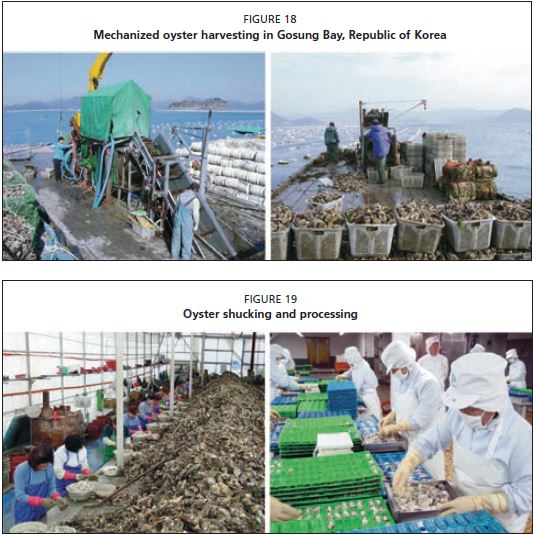SOCIO-ECONOMIC ASPECTS OF KOREAN OYSTER CULTURE
As shown in Figure 14, the southern coast of the Republic of Korea is characterized by numerous small bays and islands and extensively utilized for oyster longline aquaculture. The coastal area off the two provinces of Gyeongsangnamdo and Jeonranamdo covers
Figure 18
Mechanized oyster harvesting in Gosung Bay, Republic of Korea
Figure 19
Oyster shucking and processing

7 districts and 34 385 hectares of sea surface.
In 2005, a total of 784 oyster leases were issued by the Ministry of Maritime Affairs and Fisheries and the oyster farms located along the south coast utilized 4 479 hectares of sea surface (Table 2). Currently 90 percent of the total annual oyster landings are produced from longline culture in the south. In 2005, it was estimated that 226 535 tonnes of shell-on oysters (33 980 tonnes
Table 2
Number of leases, farm area, longlines and oyster strings in two southern provinces in the Reuplic of Korea in 2005

Figure 20
Oyster production from aquaculture and capture fisheries in the Republic of Korea from 1950 to 2005
Table 3
Quantity and value of oysters exported from 2002 to 2004

of oyster meat) were produced. From 2000 and 2005, oyster landings accounted for 23–28 percent of the total national aquaculture production (Figure 20).
According to the authorities of Gyeongsangnamdo Province, in 2005 approximately 3 000 families were engaged in oyster farming over an area covering 3 622 hectares while a further 406 families were involved in the industry off the southwest coast of Jeonranamdo Province. The Korean oyster longline culture cooperative estimates that there are 22 000 full-time employees engaged in the oyster industry from farming to processing.
The majority of the Korean oysters are exported to Japan and the United States of America. Table 3 lists the type of products exported, their quantity and value. In 2002 and 2004, 14 661 to 16 611 tonnes of oysters were exported, accounting for almost 41 to 63 percent of the total production.
In 2003, the Korean Fisheries Economic Institute analyzed the economic status of selected oyster farming companies. According to the study, an average oyster farm in Tongyoung operated 126 longlines for a grow-out period lasting 172 working days. Furthermore, the farm owner hired no permanent employees, but only temporary workers (?230 persons). The production from one farm averaged 297 tonnes worth approximately US$134 000. The net profit was calculated at around US$33 000 (excluding wages, equipment repair and maintenance, and seed cost.